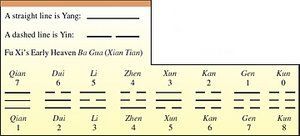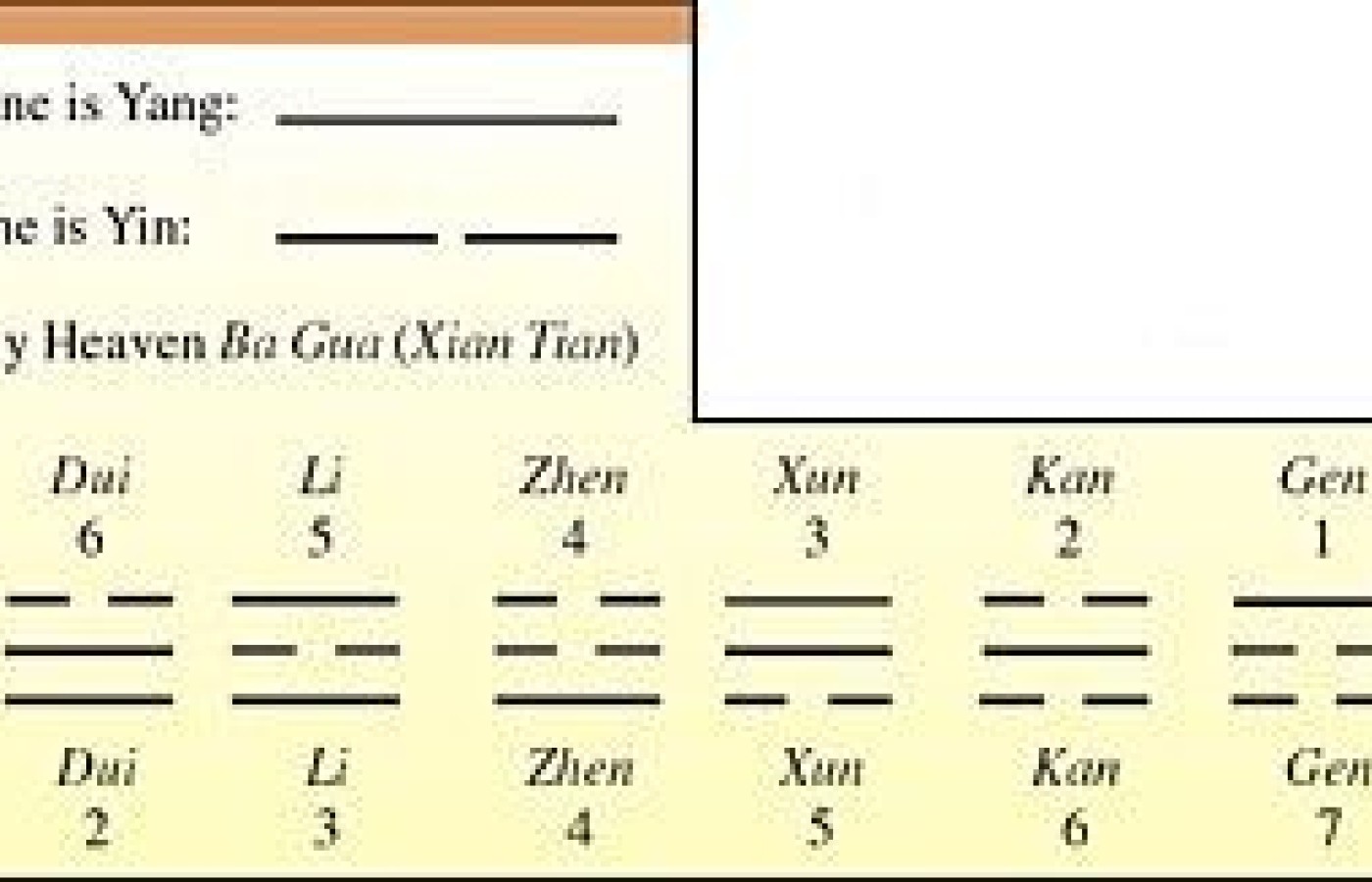One of the longest nerves in the body is known as the vagus nerve (VN). The VN is the 10th pair of cranial nerves that originates at the brain stem in the medulla oblongata. This nerve is part of the parasympathetic nervous system, which is a part of the ANS. Research suggests ear acupuncture can activate the VN.
I Ching and Cycles of Jing
Cycles of jing are the unfolding of the three treasures: jing, qi and shen. These evolutionary seven- and eight-year cycles are presented in chapter one of the classic Chinese medical text, the Yellow Emperor's Classic of Internal Medicine. The common explanation of these cycles of human evolution is based on human observation; a deeper explanation can be found in China's oldest text, the I Ching.
In Chinese culture there are two import concepts, ti and yong. Ti is theory and yong is application. Basic I Ching theory (ti) is common among people throughout the world, but its many applications (yong) are just beginning to be presented to the general public. One application of I Ching science includes patterns or formulas, some of which were discussed in my article, "I Ching Acupuncture" (editor's note: See the October 2003 issue). The principles of I Ching can be found in the Nei Jing. This article presents I Ching and Nei Jing explanations of cycles of jing.
The tao can be expressed in many ways. The following are three major perspectives:
- Qi
- Patterns (prenatal evolution, pos-natal cause and effect)
- Numbers
Qi follows patterns of an evolutionary blueprint or unfolding, which are initially guided by prenatal influences and, later, an integrated prenatal/postnatal influence. These patterns can be explained by how qi manifests in the body during cycles of time as revealed by age (numbers). Qi, patterns and numbers are really one. They are inseparable, and are different ways to view or communicate a situation and condition. Classically, cycles of jing have been explained by how qi patterns unfold through time, as viewed from human observation. The following introduces I Ching patterns that explain cycles of jing.
The following is a summary of traditional jing cycles for males and females. Males have eight-year cycles; women have seven-year cycles. Seven is a balancing or harmonizing number in I Ching science. For example, seven days complete a week and four cycles of seven days completes a month. Also, the spiritual model of hun and po found in traditional Chinese medical texts, as well as Taoist Nei Dan cultivation, view the po as corresponding to seven (either seven spirits, seven frequencies, seven stages of development or the number seven found in the west direction) in the classic Luo Shu diagram. The number eight is found in many branches of Taoist arts, including the ba gua.
Jing Cycles found in the Nei Jing
Chapter One
Female Jing Cycles of Seven
- A woman's Kidney energy becomes prosperous at seven years of age (1x7).
- Her menstruation appears as the ren (sea of yin) channel flows and the chong (sea of blood) channel becomes prosperous at the age of 14 (2x7).
- Her Kidney qi reaches a balanced state, and her teeth are completely developed at the age of 21 (3x7).
- Her vital energy and blood are substantial, her four limbs are strong and the body is at optimal condition at the age of 28 (4x7).
- Her peak condition declines gradually. The yang ming channel is depleted, her face withers and her hair begins to fall out at the age of 35 (5x7).
- Her three yang channels, tai yang, yang ming and shao yang, begin to decline. Her face complexion wanes and her hair turn white at the age of 42 (6x7).
- The ren and chong channels are both declining, her menstruation ends, her physique turns old and feeble, and she can no longer conceive at the age of 49 (7x7).
Male Jing Cycles of Eight
- A man's Kidney energy is prosperous, his hair develops and his teeth emerge at the age of eight (1x 8).
- His Kidney energy grows and is filled with vital energy, and he is able to let his sperm out at the age of 16 (2x8).
- His Kidney energy is developed, his extremities are strong, and all of his teeth are developed by the age of 24 (3x8).
- His body has developed to its best condition, and his extremities and muscles are very strong at the age of 32 (4x8).
- His Kidney energy begins to decline, his hair falls out and his teeth begin to whither at the age of 40 (5x8).
- His Kidney energy declines more, the yang energy of the entire body declines, his complexion becomes withered and his hair turns white at the age of 48 (6x8).
- His Liver energy declines as a result of Kidney deficiency; the tendons become rigid and fail to be nimble at the age of 56 (7x8).
- His essence and vital energy is weak, as are his bones and tendons. His teeth fall out and his body becomes decrepit at the age of 64 (8x8).

Jing cycles are nature's cycle of evolution. The I Ching is a tool that reveals patterns of nature and contains a code of jing. Below is Fu Xi's Early Heaven Ba Gua (Xian Tian). This ba gua is profound. It reveals much about the patterns of tian, ren and ti (heaven, human and earth).
The top line of numbers, which contains the computer method of counting, begins at the right side with 0. Zero is a yin number and represents females. This pattern reveals that females have cycles of seven years. Traditional Chinese philosophy states that yin is the right side.
The bottom line, which contains the standard counting method, begins at the left side with 1. One is a yang number and represents males. This pattern reveals that males have cycles of eight years. Traditional Chinese philosophy states that yang is the left side.
Note that yang and yin, 1 and 0, are opposite each other, following the pattern of the ba gua. Qian at the left is three yang lines and is pure yang, or male. Kun at the right is three yin lines and is pure yin, or female.
Female jing patterns of seven multiplied by male jing patterns of eight, multiplied by five (for Five Elements) equals 280. Two hundred-eighty divided by 30 is 9.33. This is the ideal duration of pregnancy (just over nine months).
The I Ching and Nei Jing emphasize the principles of "yin within yang" and "yang within yin." This principle is illustrated in this ba gua pattern.
- Females are yin and correspond to the number seven, which is an odd or yang number. This is yin within yang.
- Males are yang and correspond to the number eight, which is an even or yin number. This is yang within yin.
- Dividing 280 by five, the result is 56. Fifty-six divided by female cycles of seven equals eight, the pattern for males. This as an example of yang within yin. Similarly, 56 divided by male cycles of eight equals seven, the pattern for females. This is an example of yin within yang.
The ancients developed many acupuncture methods based on the patterns of the I Ching and the ba gua. These methods tap into the forces of nature to support one's life, whether it is feng shui, Chinese astrology or Acupuncture. The I Ching is a profound book that contains general guidance for healthy living. Hidden inside this ancient book are patterns that explain many of the principles found in the Nei Jing and other classic books on Chinese medicine.
References
- The I Ching pattern of jing cycles is based on the teachings of Dr. Chao Chen.
- Nei Jing reference: Yellow Emperor's Canon of Internal Medicine, China Science & Technology Press.
- I Ching Acupuncture by Dr. Chao Chen, Yu Chen, and David Twicken.
- Treasures of Tao by David Twicken.



